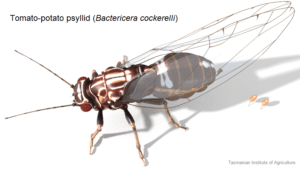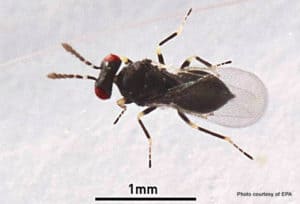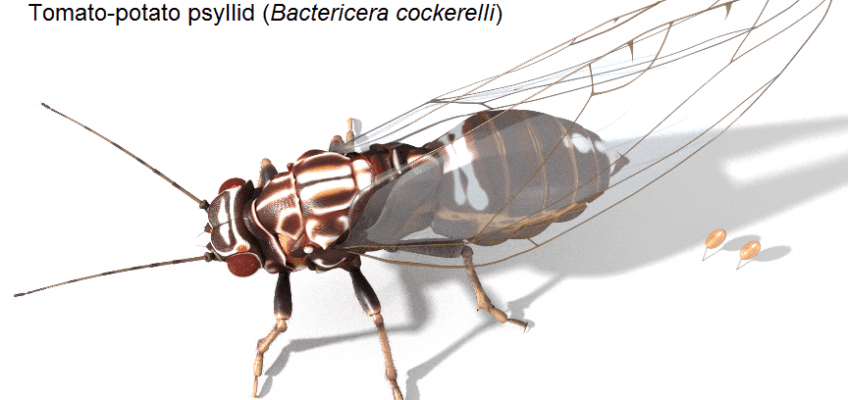It is crucial that growers and the wider potato industry make submissions on the application.

A collective of horticultural industry groups comprising Potatoes New Zealand Inc, Tomatoes NZ Inc, Vegetables NZ Inc, Heinz-Wattie’s NZ Ltd, and NZ Tamarillo Growers Association Inc has applied to the Environmental Protection Authority (EPA) to import and release a biological control agent to assist with the control of the tomato potato psyllid (Bactericera cockerelli).
The tomato potato psyllid (TPP) was first detected in New Zealand in 2006 and is a serious pest of solanaceous crops. It has caused significant economic losses of well over $100 million to New Zealand’s potato, tomato, capsicum and tamarillo industries.
TPP not only causes damage to the crops it feeds on but also transmits a plant disease (Liberibacter) which causes yellowing of leaves, wilting and stunting of growth and reduces quality and yields. In potatoes it also causes browning of potato tubers and they are unsuitable for processing.
From the first detection of TPP in NZ in 2006 horticultural groups in collaboration with Plant and Food Research, with the support of MPI’s “Sustainable Farming Fund” have been carrying out research to understand and manage TPP in New Zealand. One aspect of this research is to look for biological control agents.
It is crucial that growers and the wider potato industry make submissions on the application. The submissions do not have to be long but need to explain how TPP impacts your businesses and how a biological control agent such as Tamarixia will benefit your business, staff and most importantly your local community.
Supporting submissions from growers affected by TPP will be critical as the EPA decision-making committee assesses the application.
IMPORTANT – How to make a submission in support of the EPA application
Please support your industry!
FAQs to inform submissions.

The biological control agent – Tamarixia triozae – is a small wasp and is a parasitoid of TPP. Tamarixia will lay its eggs on TPP, when the eggs hatch the Tamarixia eat the TPP. Tamarixia is found naturally in North America and Mexico – where TPP is also found.
Tamarixia triozae has been found primarily in arid or semi-arid regions of North America (Arizona, California, Colorado, Idaho, Kansas, Montana, New Mexico, and Washington), and has been recently found in Mexico.
Tamarixia triozae was originally identified by US researchers as a potential BCA and testing has been carried out in containment in New Zealand to ensure Tamarixia will not harm NZ psyllid species. This research forms the basis of the application to the EPA.
The release of Tamarixia will enable growers to achieve more effective and sustainable management of TPP through integrated pest management (IPM) and inclusion of Tamarixia into these IPM programmes.
TPP and the plant disease it transmits have already had a devastating effect on smaller commercial taewa growing units, such as marae gardens in the North Island, with crop losses of up to 90%. This has resulted in the inability to supply taewa for cultural use, economic gain, or as carry over seed tubers for future seasons. Introduction of Tamarixia triozae will help traditional Māori food growers (of taewa, kūmara, and poroporo) to control the tomato potato psyllid and support the ability to grow crops sustainably for family and marae using traditional cultivation methods. The benefits for Māori food growers also apply to home gardeners enhancing their ability to grow and provide food for their families.
Environmental benefits:
The introduction of Tamarixia triozae would enable horticultural industries to develop more sustainable pest control programmes that integrate biological control agents and compatible insecticides. This reduces reliance on broad-spectrum insecticides that kill a wide range of insects and will result in improved environmental outcomes such as reduced risk of agrichemicals entering waterways.
Tamarixia triozae does not cause any damage to plants; it is specifically a natural enemy of TPP.
Health and wellbeing:
Adoption of an integrated pest control programme to control TPP will improve human health outcomes by reducing the use of broad-spectrum insecticides on crops. For example, by reduced risk of exposure to spray drift.
Tamarixia triozae is not known to swarm, bite or sting, or considered a nuisance. Therefore for no adverse effects on human health are anticipated.
Economic benefits:
We commissioned the NZ Institute of Economic Research to carry out an independent economic assessment to measure the costs and benefits of introducing Tamarixia triozae. The outcome from this analysis was that the overall benefit was conservatively valued at between $4 million and $12.2 million per year over 20 years. The conclusion from this analysis was that the introduction of Tamarixia triozae is likely to have a positive economic benefit for New Zealand.
In New Zealand there are already some insects (ladybird, hover fly, and lacewing) that will feed on the tomato potato psyllid. These insects only provide limited control to TPP. Tamarixia triozae would add to the effectiveness of these other insect predators and enable us to reduce the use of insecticides while achieving better control of the tomato potato psyllid.
We carried out testing to assess the potential impact that Tamarixia triozae might have on New Zealand psyllids. This testing was done by exposing seven native psyllid species to Tamarixia. The seven species selected were representative of the groups of psyllids native to New Zealand. The exotic Broom psyllid was also tested (eight psyllid species tested in total). This is type of testing is referred to as host range testing.
Key findings:
- Our host range testing confirmed that Tamarixia triozae will not cause significant risk to native psyllid species or cause significant deterioration of natural habitats.
- Tamarixia triozae did not attack five of the native psyllid species tested. Although eggs were laid on the Pōhutukawa psyllid the eggs did not hatch and did not affect the psyllid.
- Tamarixia triozae eggs did hatch on the Houpara psyllid but did not survive and reproduce. The number of eggs laid on these two native psyllid were very low and Tamarixia triozae either did not hatch, or hatched but did not survive or reproduce.
- Tamarixia triozae will not lay eggs on the exotic Broom psyllid.




